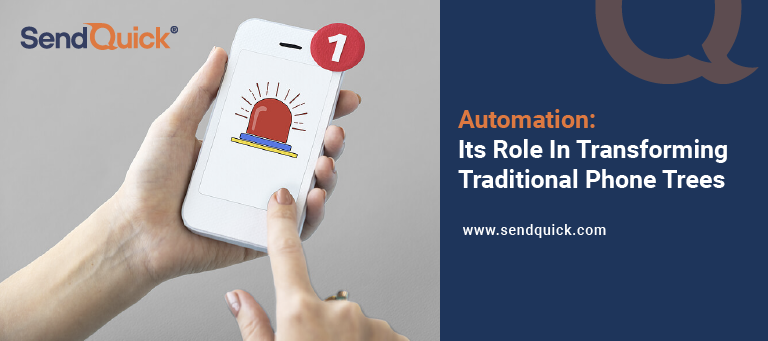The phone tree, also known as the call tree, is a concept that had existed in some form or another well before the invention of telephones and telephony itself came to be. Its purpose is to organise and coordinate people by disseminating information quickly and accurately through multiple channels or people. Once telephones were invented, real phone trees followed suit, and distributing critical information to many people became much easier than ever.
Phone trees function similarly to a pyramid wherein the first caller, who is at the pyramid’s peak, calls two people. Those two will then call two more people and so on, with the number of individuals getting called rising exponentially. Despite the concept’s simplicity, the actual execution of this manual process is far from it.
The problem with this approach is that it is not always reliable since gaps are bound to appear. For example, if one person does not answer, the original caller must proceed with their list and then take on the responsibility of calling the people on the missed person’s list. What happens when situations like the second person on their list also did not answer the call? The original caller would take on a greater workload resulting in delays to compound.
The main problems affecting manual phone trees
Manual phone trees are generally slow, inefficient, and inaccurate. Word of mouth is the traditional way messages are distributed between humans, and verbally sharing it often leads to the message being less accurate. This loss of accuracy is typically common in the children’s game “Telephone”, a simplified version of the phone tree concept. Some players tend to misremember or outright forget certain details, and key facts are omitted.
Furthermore, during times of crisis where every second counts, alerting people with time-sensitive information via a manual phone tree is highly inefficient. This is because spending time on a phone call from dialling to hanging up — let us say for an average of 3 minutes on each one — all adds up, and it would take far too long for the remaining people at the lowermost layer to get the message. In most cases, no one can afford to wait that long. In times of emerging threats, speed is paramount, and the cascading nature of manual phone trees takes too much time than one can spare during emergencies. In short, this slow and inefficient method based on sequential dialling no longer suffices today.
When the medium is now the message
Another issue to consider is the medium of distributing messages. Even when only one medium was used in the “Telephone” game, it still proved difficult to win. The issue is exacerbated in today’s world where there are now multiple ways to communicate with one another, from text messages to online messaging platforms. In short, the medium is the message. This is why call tree systems in Singapore must have multi-channel support and cater to different formats and devices.
How automating phone trees address these issues
Most organisations cannot afford to wait minutes, much less hours for critical messages to reach their people amid an incident. Fortunately, human behaviour and technology have evolved in the last few decades. Everyone has a smartphone in their pocket, meaning people have instant and constant access to SMS, phone calls, social media, web chat, email, and other communication channels. Similarly, automated call trees shoulder the responsibility of those people in manual call trees and reliably disseminate information swiftly to any group size.
What is an automated call tree?
An automated call tree is an improved version of the manual call tree that eliminates its inherent inaccuracies and delays. Instead of relying solely on individuals to deliver vital messages, an automated call tree system enables organisations to send messages to all relevant recipients via different channels and devices.
The main benefit is that messages are guaranteed to be read by those who receive them. Call tree software simplifies uploading recipient information, including all available communication channels, and drafting customisable message templates for various incidents. If bad weather strikes or there is an impromptu change in an event, organisations can easily and quickly tweak these messages and send them at once. Messages arrive in mere seconds to minutes—not hours.
The key capabilities to look for in an automated call tree solution
1. Customisation
No two events are alike, be it in routine communications, such as reminders about planned events or urgent threats. Customising messages for unique events and devices are an indispensable feature of any automated call tree.
2. Relevancy
Creating contact groups allows companies to notify only the relevant people they need to reach. An automated call tree should allow unlimited contact subgroups to narrow the delivery from specific office branches down to individual floors or even teams and departments. Having additional filters for dynamically creating groups is also a plus.
3. Speed
Choose a solution that allows for pre-recording messages and saving them in a library. This is a key feature that is not only ideal for recurring and standard events but also emergencies.
4. Immediacy
Organisations must determine exactly who received their message and who did not respond in real-time. The right automated call tree solution will enable continuous status updates upon sending a message, allowing quicker management of wrong phone numbers and instant access to polling responses.
Conclusion
Disseminating critical updates and information at an organisational level is one of the fundamental aspects of a successful crisis management plan. With the increasing complexities of modern businesses and the risk of an inadequate and late response, it is vital to adopt an automated call tree system that ensures all relevant parties necessary to execute their roles are notified.
For a reliable automated call tree system, check out SendQuick Assure, which enables you to instantly send out alerts to all of your stakeholders and staff in the event of an emergency.
More than just a local SMS gateway provider in Singapore, SendQuick has been offering excellent enterprise mobility management services for businesses to improve communications since our establishment in 2001. Besides automated call tree systems, we offer a range of mobile messaging solutions that can help you overcome alert fatigue and propel your business forward, such as our IT alert management system, enterprise broadcast messaging solutions and more.
For more information, feel free to contact us and a SendQuick expert will assist you with all your queries.






